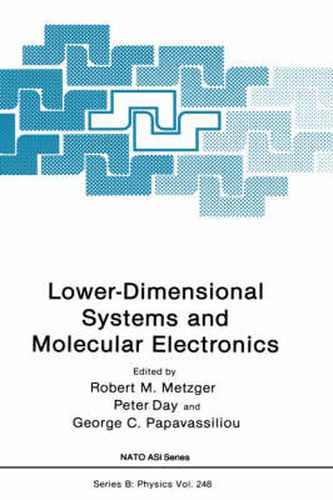Readings Newsletter
Become a Readings Member to make your shopping experience even easier.
Sign in or sign up for free!
You’re not far away from qualifying for FREE standard shipping within Australia
You’ve qualified for FREE standard shipping within Australia
The cart is loading…






This title is printed to order. This book may have been self-published. If so, we cannot guarantee the quality of the content. In the main most books will have gone through the editing process however some may not. We therefore suggest that you be aware of this before ordering this book. If in doubt check either the author or publisher’s details as we are unable to accept any returns unless they are faulty. Please contact us if you have any questions.
This volume represents the written account of the NATO Advanced Study Institute Lower-Dimensional Systems and Molecular Electronics held at Hotel Spetses, Spetses Island, Greece from 12 June to 23 June 1989. The goal of the Institute was to demonstrate the breadth of chemical and physical knowledge that has been acquired in the last 20 years in inorganic and organic crystals, polymers, and thin films, which exhibit phenomena of reduced dimensionality. The interest in these systems started in the late 1960’s with lower-dimensional inorganic conductors, in the early 1970’s with quasi-one-dimensional crystalline organic conductors. which by 1979 led to the first organic superconductors, and, in 1977, to the fITSt conducting polymers. The study of monolayer films (Langmuir-Blodgett films) had progressed since the 1930’s, but reached a great upsurge in . the early 1980’s. The pursuit of non-linear optical phenomena became increasingly popular in the early 1980’s, as the attention turned from inorganic crystals to organic films and polymers. And in the last few years the term moleculw’ electronics has gained ever-increasing acceptance, although it is used in several contexts. We now have organic superconductors with critical temperatures in excess of 10 K, conducting polymers that are soluble and processable, and used commercially; we have films of a few monolayers that have high in-plane electrical conductivity, and polymers that show great promise in photonics; we even have a few devices that function almost at the molecular level.
$9.00 standard shipping within Australia
FREE standard shipping within Australia for orders over $100.00
Express & International shipping calculated at checkout
This title is printed to order. This book may have been self-published. If so, we cannot guarantee the quality of the content. In the main most books will have gone through the editing process however some may not. We therefore suggest that you be aware of this before ordering this book. If in doubt check either the author or publisher’s details as we are unable to accept any returns unless they are faulty. Please contact us if you have any questions.
This volume represents the written account of the NATO Advanced Study Institute Lower-Dimensional Systems and Molecular Electronics held at Hotel Spetses, Spetses Island, Greece from 12 June to 23 June 1989. The goal of the Institute was to demonstrate the breadth of chemical and physical knowledge that has been acquired in the last 20 years in inorganic and organic crystals, polymers, and thin films, which exhibit phenomena of reduced dimensionality. The interest in these systems started in the late 1960’s with lower-dimensional inorganic conductors, in the early 1970’s with quasi-one-dimensional crystalline organic conductors. which by 1979 led to the first organic superconductors, and, in 1977, to the fITSt conducting polymers. The study of monolayer films (Langmuir-Blodgett films) had progressed since the 1930’s, but reached a great upsurge in . the early 1980’s. The pursuit of non-linear optical phenomena became increasingly popular in the early 1980’s, as the attention turned from inorganic crystals to organic films and polymers. And in the last few years the term moleculw’ electronics has gained ever-increasing acceptance, although it is used in several contexts. We now have organic superconductors with critical temperatures in excess of 10 K, conducting polymers that are soluble and processable, and used commercially; we have films of a few monolayers that have high in-plane electrical conductivity, and polymers that show great promise in photonics; we even have a few devices that function almost at the molecular level.